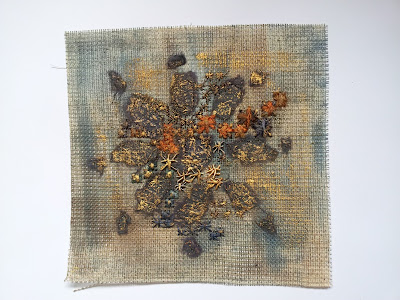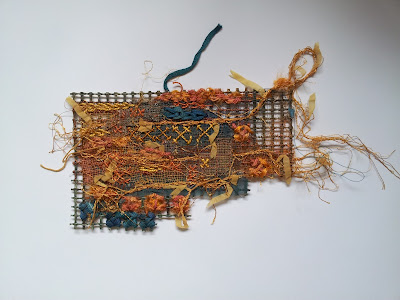Having looked at the work done in previous assignments I like the pieces that have texture and layering. When looking for inspiration I am finding that it is the texture of any object that I am drawn to as well as colour. I think this is why I am so drawn to the tug boat that has become the main inspiration for my theme book. I also like delicate stitching and think that I will like to combine textured backgrounds with stitching.
Stage 2 - Focusing on your theme book
After looking through the work in my theme book I decided to colour different fabrics to try to emulate the textures I wanted to achieve. I used a variety of materials including silk habotai, scrim, calico, pelmet vilene and wool blanket. I painted bondaweb with acrylic paints. When this was dry I ironed it onto velvet, scrim and light interfacing.
I am pleased with the results and decided to start doing samples using these fabrics long with others I had collected together in the colour range I wanted to work with.
I have drawn grasses from the river bank onto water soluble fabric. I intend to free machine embroider on these and attach them to the textured backgrounds.
The sample below is a light interfacing with painted bondaweb fused to it. I have then hand embroidered grasses with a fine space dyed cotton thread.
Below is velvet with two organzas fused to it. I then free machine embroidered grasses using water soluble fabric that I had drawn on as a template. The water soluble fabric will be washed away.
Stage 3 Developing your design
Looking through my theme book I realised that it is the surface texture and colour of the rusting surfaces on the tug boat that attracts me. I also like the fine grasses that grow along the river bank. I wanted to try to combine the two in my work.
I began by colouring a selection of fabrics and then layering them. I wanted to get a very textured background fabric and then embroider finely onto this to simulate the grasses.
I feel the background fabrics that I constructed were successful. However when I started to embroider onto them by machine and by hand I felt that I was failing in what I have envisaged. I decided to strip back as it were and work on fabric that was not as heavily textured. I then worked running stitches onto fabrics that had just been painted and not layered. I began to think about the holes on the tug boat that had appeared within the rusted surfaces and patching these. I worked some darning on cotton and silk scrim. I really liked the delicate effect but it wasn't the one I had envisaged.
I became really stuck at this point as I started to think about the design of the final textile piece. I had not a clue what to design. I could not see any of the samples starting to lend themselves to a garment, cushion or bag.
When I had last spoken to my Tutor she made suggestions about my working small as I had done with a piece of weaving in one of my previous assignments. I do like to work small and love delicate fabrics and embroideries. She suggested that I go to see an exhibition called 'Meticulous Stitchers' that was on at Unit Twelve Gallery in Stafford. She said I may be inspired by some of the work at the Gallery. I went to the exhibition and was loved the work of all the artists. It was lovely to see the different approaches to textile art. I was inspired by the work of Hannah Watson. She had exhibited tiny delicate knitted pieces in box frames. I really liked the idea of making small samples that could be put into box frames. This was something my Tutor had suggested and after seeing the exhibition I could see what she meant.
I feel the samples I was doing were becoming too cumbersome. I coloured some silk noil and loved the way the background emulated the colours I had seen in the boatyard. I decided to keep the piece simple and did small running stitches in rows on the piece. I then ripped the sample into pieces. They are very simple but I really like the effect. I think it is because I am first attracted to the colour of something and then like to look closer.
Snippets of fabric and thread sandwiched between water soluble material, machined stitched and the soluble material dissolved.
Silk tops, throwsters waste, organza layered onto painted batting. Hand stitching.
Cotton scrim partly painted with darning stitches in silk threads
Painted scrim, organza pulled work and darning.
Dyed batting with hand embroidery in linen thread
Dyed silk noil background, pieces of silk that had been shibori dyed and hand stitching in linen thread
Dyed silk and shibori dyed silk machine stitched onto dyed batting.

Painted bondaweb applied to dyed cotton.
Layers of coloured organza applied to dyed calico, weaving and machine and hand embroidery. I think these two samples are too messy. I think the weaving is more successful than the hand and machine embroidery because it is simpler. I think the colours are successful in that they compliment each other.
Free machine embroider on dyed calico with added silk tops. I feel this sample is a disaster. I was trying to emulate the grasses from along the river bank but over did it with the machining. I tried to 'knock it back' by changing the colour of thread but decided to abandon it as I felt it was not working and was just getting messier and messier.
To try to get a textured effect I used a a fabric called Texture Magic on the back of the following samples that after being stitched to the back the sample is steam ironed and the fabric shrinks in all directions.
The first sample is calico with painted bondaweb applied. I then sewed a grid to this after it had been backed with the Texture Magic. I like the texture it made after ironing but feel I should have not done such a rigid grid. I think it would have looked better if I had free machined over the fabric with perhaps vermicelli stitching to give a more natural look.
Dyed cotton fabric with ironed on painted bondaweb. Machine stitching. Torn into strips and then strips woven together. Hand stitching then added.
Dyed silk noil with hand stitching in a variegated thread.
Painted canvas with handmade paper and canvas work stitches.
Stage 4 Making your textile piece
I have struggled with the previous stage of the assignment in that although I have been able to make lots of different samples I have not been able to see them working towards a final piece. I cannot see them lending themselves to work in a functional final piece. I think this is because I have focused on the texture and colour from my inspiration. Although I said I have struggled with the development of a piece I am pleased with the work I have done. I feel that I have captured the texture and colours I have wanted. I do feel that I have perhaps had too much inspiration to work from if that is possible. Thinking now I feel that I should have concentrated on one technique in my samples and taken that further rather than taking the texture and colours further. Looking through my samples I am pleased with the results but can see that maybe I have been jumping around a lot and seem to have lost focus.
As I worked the samples I could see them becoming individual pieces that could be framed maybe with three or four working well together. I cannot see them being worked towards something such as a cushion, bag or garment.
Looking again I can see that maybe the woven piece and the canvas pieces could be centre panel in a decorative cushion. However, I do not feel fully happy using these ideas in a final piece because they seem cumbersome and overworked and not what I had in mind. I know that what one has in mind at the beginning can change and go in a completely different direction but I am not settled with these pieces.
Reflection on course
Before I started the course the following bullet points were what I hoped the course would do for me.
- Help structure the way I work.
- Broaden my experience towards designing textiles.
- Help me to make working in a sketchbook become part of my daily life.
- Give me the confidence to develop designing using a variety of techniques and media.
- Broaden my knowledge and interest in artists and textile artists.
Help structure the way I work - I am definitely able to work in a more structured logical way especially when working on my learning blog and writing reflectively. Working on my learning blog was daunting at first but as I have worked through the course I began to enjoy writing reflectively and find that it is good to organise my thoughts by writing in this way.
Broaden my experience towards designing textiles - Although I had a certain amount of knowledge about textiles and their design before starting the course I have learnt new techniques that I can take forward into my work such as printing and weaving.
Help me to make working in a sketchbook become part of my daily life - unfortunately I have not been able to make this part of my daily life mainly because of family circumstances during the time I have been doing the course. This could not of course be helped but I am determined to be able to work in my sketchbook daily. When I do have time to do this I do tend to struggle as I am not always sure what I should be working on in my sketchbook. Again this is something that I am definitely going to rectify.
Give me the confidence to develop designing using a variety of techniques and media - I really feel that I have been given much more confidence in the way I work and the confidence try out different techniques and media. What I do need to do is not get overwhelmed with all the different choices and then let that affect the confidence I have gained. My tutor has been a very big help with my gaining confidence in that she has guided me when I was losing direction and I have had an issue with whether I am doing something in a right or wrong way.
Broaden my knowledge and interest in artists and textile artists - I have for a very long time been interested in the work of textile artists and this course has helped me to get more from viewing and researching their work. I have been introduced to textile artists I had not heard of and to artists from the past and artists of today. I have learnt how to look and reflect on their work and how to use this knowledge to take it forward into my own work. I now look at artists work much more closely and have learnt to ask myself questions about it and especially what it is I like or dislike about a piece and importantly why.
Overall I have enjoyed doing this course very much. I feel I have had support and advice whenever I have needed it from both my tutor and the support staff at the OCA. I have sometimes found the course materials slightly ambiguous but as my confidence grew I realised these are a guide and I could work around them and become more confident in working towards my own style. I am looking forward to continuing my studies with the OCA.
















































